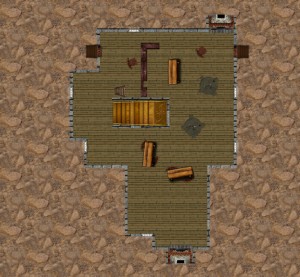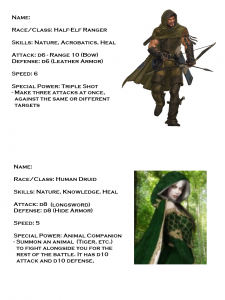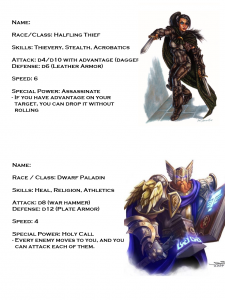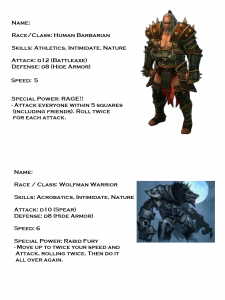Labor Day weekend in Colorado is a special time. Sure, it’s a great time to enjoy outdoor activities as summer wanes, but for me it’s exciting because it’s TactiCon time!
There are two big local gaming conventions here in Colorado each year. The bigger one is Genghis Con, which takes place over Presidents’ Day weekend in February. The smaller one is TactiCon. Both have lots of RPGs, board games and miniatures games, complete with a good-sized exhibit hall.
They also have Con Jr., which provides kids of con-goers with gaming of their own. I don’t have kids,so I’ve never been involved with Con Jr., but this year I decided that I’d run a game for kids.
You may have seen my post about the Kid-Friendly RPG (KFRPG), the simple game I designed when my young niece and nephew were visiting last Christmas. I figured I should bring this game to Con Jr.
Preparation
To get ready for the game, the main to-do was to create more characters. I said I could have up to six players, and I only had eight character sheets prepared from last December’s game. I wanted to make sure the kids in my game had more choices.
Basically, I created male and female versions of the existing eight characters, with a few tweaks to make the characters match the pictures I found online.
As a recap, KFRPG characters are pretty simple. They consist of:
- Race and class
- Attack die and defense die
- Three skills
- One special power
I always include a big picture of the character (using a Google Image Search, for personal use only) and a spot for the player to name the character.
I put my copy of Masks in my bag for the game. This is a cool book in general, but I keep in on hand because of the running lists of random character names at the footers of the pages. What is that NPC’s name? Let me look that up (flip, flip, flip…).
I also had to make sure I had the physical supplies on hand that I would need:
- The printed character sheets (half page each)
- Three red poker chips (hit points), one green poker chip (healing potion) and one blue poker chip (special power) for each player
- Dice that I didn’t mind giving away (I bought a pitcherful at Gen Con)
- Minis to represent the player characters (I bought a bunch of plastic ones on day 2 of TactiCon)
Finally, I had to make sure my projector setup was ready to go. The projector and rig still work great after three years. As for a MapTool file, I use this one. It has a bunch of different maps on hand, so that my players can go wherever they like. I also have tons of monster and NPC tokens set up in MapTool that I can drop onto the map at any time.
KFRPG is intended to be very free form, letting the players go to bizarre places. And as you’ll see, they did!
Setup
My game was scheduled to start at 11:00 Sunday morning. On Saturday afternoon, I found the room where I would be running the game, just so I would know where to go. I made sure I arrived about 20 minutes before the scheduled start time on Sunday, so that I would have enough time to set up.
As it turned out, there was a Ticket to Ride game that lasted all the way to 11:00 AM in that room, so I had to set up the projector and my supplies quickly when that game ended. The organizer gave me a few extra minutes to get this in order before sending in the kids.
I had a table of six boys, ranging in age from about 7 to 11. All of them had some familiarity with fantasy role playing, many having played D&D before. I had never met any of these kids before.
I started by passing around the character sheets, letting the kids pass them back and forth and swap with one another until they were happy with what they had.
One kid had this gigantic dragon mini that he wanted to use for his character. I told him that he could be a druid and the dragon could be his animal companion that he could call upon with his special power.
The other kids picked a wizard, two rangers, a dwarf paladin and a wolfman warrior (although I didn’t have a wolf mini, so he was really an elephant man).
Scene 1: The Rusty Lantern Inn
Since I’m going for a straightforward game when it comes to KFRPG, we all began in an inn, the Rusty Lantern. There were a couple of dwarves in one part of the inn, a couple of elves in another part, a human woman (Val) running the place, and a burly human man fetching food from the outdoor kitchen.
I had an adventure hook ready for whenever the kids needed it: An evil wizard known as Kalor the Terrible is rumored to be active in the area. No one ever sees Kalor himself, and accounts vary as to exactly what he looks like, but he leaves his signature in flaming letters in places where he has wrought havoc.
But rather than forcing this on them, I asked the kids what they wanted to do. Some wanted to chat with the elves, so I had the elves tell them that they were fleeing their homeland because Kalor the Terrible had been there.
The dwarves had heard of Kalor, but said that he was more of a legend from hundreds of years ago.
Val the innkeeper said she had some information about Kalor being active in the same region as the Rusty Lantern, which freaked out the elves.
The kids thought this sounded pretty good, so they wanted to press Val for more information. But before she was willing to trust them, she had something she wanted them to do for her first:
Kill the rats in the basement of the inn.
Yes, I wanted the adventuring cliches to flow thick and heavy! Let’s kill some rats.
Time for a cliffhanger!
Since this post is getting so long, I’m going to break it into two parts. Tomorrow, the battle begins!
Michael the OnlineDM
@ClayCrucible on Twitter





